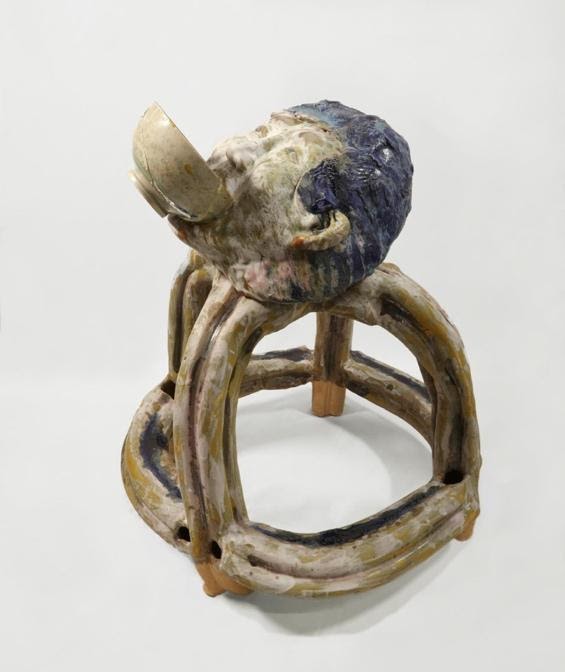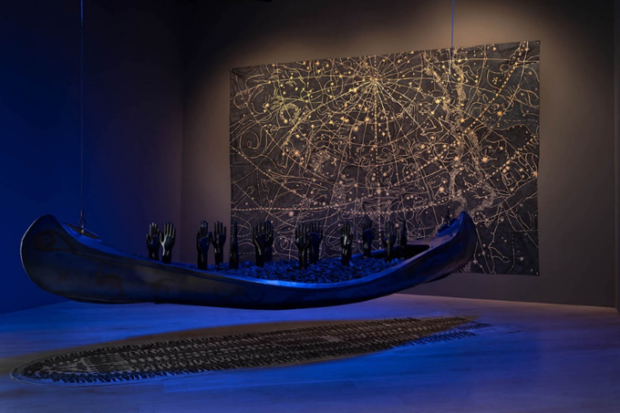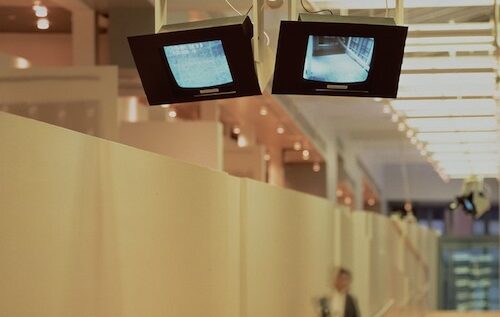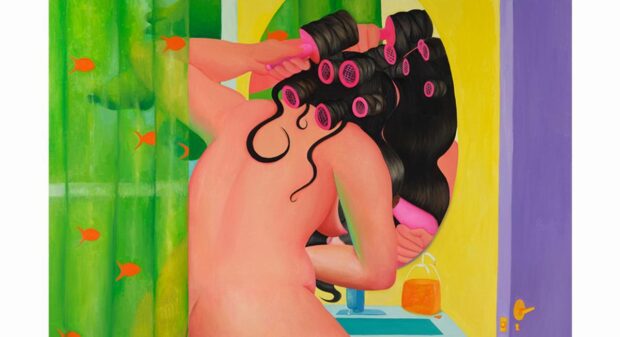This interview was conducted on December 9th, 2021 as part of New York University’s Curatorial Collaborative. This initiative matches BFA students from NYU Steinhardt with graduate student curators from the Institute of Fine Arts. In the first exhibition of the series, The Universal in the Personal, curator Juul Van Haver explores the artists’ personal backgrounds as a means of investigating global issues such as ethnicity, injustice, and origin. Artists Caleb Williams and David Ma both question where to locate their diverse cultural backgrounds, yet these friends work side-by-side in Steinhardt’s studios. Through mythical colors and forms, the works touch upon critical and social questions. Although the exhibition is embedded in the context of the contemporary world, Williams and Ma look towards a future of gradual healing. The exhibition is on view12pm until 6pm daily from Thursday, February 3rd until Sunday, February 6th, at the 80WSE Gallery.
Juul Van Haver (JVH): Juul Van Haver is a Master’s student in art history at the Institute of Fine Arts who focuses on modern and contemporary art. In this exhibition, he combines works by these two upcoming artists that uncover common human themes in these deeply rooted personal stories.
-

Caleb Williams (CW): Caleb Williams grew up in Queens and is a senior BFA student at NYU Steinhardt. Williams considers herself a multi-media artist, and explores themes such as social injustice, vulnerability and identity through video, painting, collage, photography and sculpture. -

David Ma (DM): David Ma grew up in Queens and Virginia and is a senior BFA student at NYU Steinhardt. His interdisciplinary practice of video, ceramics, and painting reveals the vibrant, often complicated portrayals of Asian representation in American culture.
Juul Van Haver: What are some of the themes that you explore in your art?
Caleb Williams: My artwork revolves around social justice, vulnerability, identity, rituals and healing.
David Ma: My art revolves around a memory of people, place and material. With this I mean that I’m overloaded with so much digital content that I feel the need to record and archive certain moments to understand and appreciate them. My art allows me to process what is happening through reimagined experiences. There are so many small details of an experience that I don’t really notice until I reflect back on them in my archives. It allows me to pause and really get to see the full picture.
JVH: So, it is a way to slow down. I feel like you, Caleb, are doing the same thing when you talk about healing and spiritual power. Your art becomes a way to process and deal with the world.
CW: Yes, in a way that is true.
DM: And then to return to “place,” I felt a lot of nostalgia for my idea of Flushing (Queens, New York) when I moved to Virginia. When I came back, it felt the same but different. I was chasing a ghost memory of the place. I didn’t know anyone who lived there, but the constant energy of people and activity was still the same. When it comes to material, I am really interested in how a material can create texture but also in how it can capture experience.
JVH: Your art seems involved with the idea of “community” and has a healing effect for certain people. Is this one of your primary goals?
CW: Yeah, something I wanted to mention about your previous question was this idea of reclaiming the body of women of color who have been subjected to sexual violence. So, that is one community to which my artwork has pertained to. However, it is more a “feeling through” the work in itself not so much just feeling bad or pitying. It’s more about understanding the process that people have gone through and acknowledging the consequences that come with that.
JVH: So, would you say your art empowers certain people?
CW: Yes, that’s my hope. People will always perceive my artwork in a way that they choose to perceive it, but I can only hope that through the repetition of the healing process – that for example comes up in my videos – the viewer will understand what my work is about. The more activist, social justice artworks are about educating the people. That is really important to me. I am trying to change the narrative of how Black and brown people are seen. Recently, I have been experimenting with new ways to do that.
JVH: Do you think that to change the public narrative you have to create your own personal narrative? Is your personal standpoint a way to intervene in the public discourse?
CW: It depends on the work I am creating. Recently I went to Birmingham, Alabama, for a football game between two historically Black schools. It was interesting that the schools weren’t from Birmingham but were coming together there to play. Moreover, Birmingham has such a rich history. Just going to a space where Black people are able to celebrate together was an example for me that the narrative is changing in real time. I managed to capture that on film.

JVH: So, is filming for you a way to mirror reality? To rethink something or to create a meta perspective?
CW: Yes, definitely.
DM: Just like Caleb, I can only hope that my art can heal. The work is originally created to understand myself and process my surroundings. I heard a nice quote the other day: “Art as resistance.” Even in the creation of art you are healing a part of yourself, hopefully other people can see this and feel affiliation or feel represented. It is a fact that there isn’t enough Asian American representation in the media. There are only a handful of people who are making the art that represents the Asian American population which is already a really broad group.
CW: I feel the same way as David. I never go into my artwork thinking about other people, it is more about processing certain things for myself. Because I am being vulnerable it can be useful for other people.
JVH: Let me ask some specific questions about some of your artworks. Caleb, your video work, The Ending of the Cycle, is deeply engaged with cleansing and spiritualism. Do you think that these are good models or methods to deal with trauma and how do you think it functions?
CW: Spiritualism and cleansing is how I coped with trauma. I believe that my spirituality through Christianity has helped me, but in that video, I was questioning how to end generational trauma. It is an investigation on how to break this cycle of trauma.
JVH: This brings us to your work, David, Selfless Family/Selfish Boy because it also deals with, not necessarily trauma, but a personal burden.

DM: That piece is, in essence about going against what is culturally expected of you. Immigrating to the US is very difficult and making money is a big challenge. Therefore, my parents really ingrained [the value of money] in me. So, going against the norm to be an artist and live an unstable life is slightly frowned upon. They don’t think it is bad but they don’t want me to starve. Breaking this generational pressure was really freeing for me.
JVH: I guess it is kind of a bad narrative or pressure from above that surrounds this topic. It seems that you are creating your own personal story in this larger context. Do you have any strategies to translate your personal experiences into an artwork that addresses an audience?
CW: I had created artworks with a bunch of statistics, police reports and articles but I realized that I wanted to move away from the canvas and present this heavy and rich information differently. I now took that information, put it in a form and tried to get an emotion from an audience. For the work I Am Just a Kid I took children’s shirts and explored how these minimalist forms can release a deep emotion from the viewer. However, I also wanted to include actual data such as police mugshots.
JVH: How much does the medium of your choosing impact the message you try to convey?
CW: For me, sculpture was a new medium I hadn’t worked with in the past which opened up new strains of thought. For months, I had to figure out the medium but now I am finally at a point where I know what I’m doing. I do consider myself an interdisciplinary artist and I’m currently opening another door with sculpture.

JVH: David, what is the relation between your interest in ceramics, video, and large paintings?
DM: I am interdisciplinary in the sense that I like to combine a lot of different materials. I’m more interested in the material and the process than the final product. I treat each medium as an opportunity to explore different parts of my creativity. The material is my entry point to transfer my knowledge into a specific medium but I also use different materials alongside each other. In that way, there is an energy in my work that becomes immersive, sort of like installation art.
JVH: Can you talk a bit more about your Mask Jar (for Pickling/Wine) and your ceramic masks?
DM: In my work Mask Jar (for Pickling/Wine), I reflect on the past or traditional use of the artifacts (Korean Onggi jar and Chinese rice wine jar), as it encapsulates and documents the present (Covid), in the preparation for the future (fermentation). I wanted to create an artifact for the future, as weird as it sounds. My ceramic masks are about the faces or social roles in an Asian household. I created pieces that represent a son, a mother and a father. The masks I made are interactive, the viewer is supposed to put it on and thus become part of the lineage.
JVH: David, you talked about how you see yourself as an archeologist sometimes, can you elaborate on this?
DM: I have always been interested in past histories, ancient civilizations, and how societies rise and crumble. I try to investigate how our current society fits in these cycles of time. I stumble upon these found readymade items on the road and interpret them as lost objects, discarded gems, or remnants of the present. These objects have the same importance to me as a 2000-year-old piece from the Met. I allow current objects to be significant in their own right.
JVH: It feels like David’s idea of archeology functions on the level of the general because he analyzes cultures at large, while you, Caleb, seem to be more interested in an archaeology of the self.
CW: I often look back into the past to analyze it and to try to think about how I hope things will be in the future, either in my generation, or the generations to come. With regards to social justice: in school, they don’t teach a lot of things that happened in the world. A lot of the topics I talk about in my paintings or photography are things that I learned later on. We can learn a lot from the past and teach ourselves something useful for the future, but people don’t always know about the past so we have to educate them so they can think critically about it.
JVH: Finally, Caleb, can you maybe talk a bit about your most recent work I Am Just a Kid?
CW: It turned out bigger than I thought it would. So, the idea originated from an earlier painting. I really wanted to talk about Black and brown kids who have been killed by police officers. When Black and brown kids come out of their mother’s womb they are already pinned with this stereotype that the world has on us by either mainstream media or historically. We don’t get the opportunity to get into the world and claim who we are, to get “into the shirt.”

The exhibition The Universal in the Personal, presented by the NYU Curatorial Collaborative, is on view from 12pm until 6pm daily from Thursday, February 3rd until Sunday, February 6th, at the 80WSE Gallery in New York City.













Be First to Comment